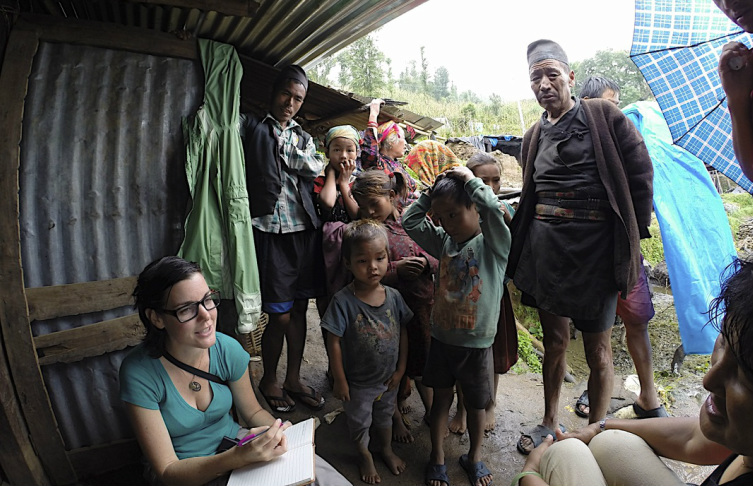
Social Entrepreneurship Program to Halt Child Trafficking in Nepal
|
I had heard the rumors. Young girls were being taken from a small Himalayan village near the earthquake epicenter.
|
We weren’t exactly sure what we’d find in the mountain village, nor did we know the danger we were headed into, so we took extra precaution during our investigation.
Our cover was that were were on assignment with a large charity conducting earthquake damage assessment, and it was our job to trek village-to-village in order to do so.
Over the course of the next three days, we’d walk up to 3-hours a day straight up the mountain, cobblestone-after-cobblestone, farmhouse-after-farmhouse, speaking with the people. They’d invite us in for tea and tell us their stories of the disaster; their hardships, their leaky roofs, their medical woes, and their dwindling food supplies. And at the end of it all, Laxmi would ask about the disappearing girls.
She made no hesitation it seemed. Laxmi, being of Tamang ethnicity seemed to make friends easily with the locals. Most at first were afraid to communicate, but others seemed to open up with time; as the peace pipe was passed around and glass or two of local Chaang was shared.
“Keep going up the hill,” they’d say. “The girls were taken from Ward 8.” And so we’d walk, higher and higher into the clouds, up the never ending path to the gateway to Heaven.
But far from Heaven were the cries in these villages. It was the opposite of Heaven, it was Hell for many.
Through Laxmi translating, I’d ask the uneasy question that needed to be asked, “where have your girls gone?”
“They don’t know,” Laxmi would reply.
“Have they been trafficked?” I quelled with heavy heart.
A father, whose daughter went missing three weeks before began to cry, “if they took her, I’d do unimaginable things to that person.”
I too began to wipe away my tears; we all did. Because all of us knew where these girls had gone; and that was to India for prostitution, never to be seen again.
I put my hand on the father’s shoulder and looked around to the group gathering in the small kitchen, “I can’t get your girls back. But I will do everything in my power to make sure another girl isn’t taken.”
The Case of the Disappearing Girls
We had already an invested interested in Shikharbesi, a district of Nuwakot. Our friends at Nepal Cyclists Ride-to-Rescue (NCRR) were working in that region rebuilding all seven schools that had been flattened after the April and May 2016 earthquakes. The loud and boisterous Australian, Jenny Caunt was leading the group, utilizing the national mountain biking team to cycle supplies up the steep mountain roads over impassable terrain, through mudslides and in between the rubble strewn aftermath of the big shake.
I loved what she was doing; using her grassroots endeavors and local sources to help where normal methods deemed useless. And so, I asked her if we could help Shikharbesi too, because during the summer Global Orphan Prevention, Helping Assist Nepal’s Disabled (HAND), and the Midwifery Society of Nepal (MIDSON) were conducting labor and delivery training, as well as rebuilding maternity wards. It seemed a remote access region such as this, coupled with the passing by from the larger charities was right up our alley.
As so that week, myself, Laxmi Tamang from MIDSON, two representatives from NCRR, and our happy-go-lucky videographer Derek Freal from The HoliDaze outfitted a jeep, hired a translator, and went on a scouting mission to Shikharbesi; a 4-hour drive up curvy mountain road with often a 800-foot drop on either side.
“You know Katie, that’s #1 child trafficking district in Nepal,” said Laxmi.
Although saddened, I thought in my heart that this was the next project I wanted to undertake on behalf of Global Orphan Prevention.
“I’m ready for anything,” I eagerly told Laxmi.
“Yes, but we’re going to have to be sneaky about it.”
The problem was, we knew the politicians and higher-caste peoples such as the Brahmin and Chetri were the ones behind it. You see, in the Hindu caste system because of reincarnation, they believe if one is born of a lower-caste, it is because they have done something to deserving of their current incarnation. Therefore, the higher castes have no problem treating them with the same value as livestock. While they’d never sell their own girls, they have no qualms selling the girls of low-castes or indigenous populations; which in this case are the Tamang.
My Plan to Halt this Vile Practice
As we were sitting in with the villagers, I asked if anyone had a solution. A young girl standing in the shadows asked to speak, and spoke softly in Nepali.
“She says that money is the problem,” Laxmi translated. “All the girls taken couldn’t afford to go to school.”
“Yes!” I was so unbelievably proud that this young girl understood the issue; without any prompting.
Indeed, money was the issue. Without an education, the girls are illiterate, thus the risk of being lured and trafficked increase ten-fold.
Since our visit, I’ve been in contact with a Nepali microfinancing company called Clean Village Microfinance Bittiya Sanstha Ltd. We are exploring income generating enterprise ideas such as Chili and Cardamom farming (both cash crops), as well as sheep husbandry for purposes of meat and textile opportunities.
So how can you help? It’s easy; we are needing individual and corporate sponsors to make this happen! If you are not in a position to contribute financially, please help us share our campaign on social media and with your friends! Remember, I can’t do this alone. To learn more, email info@globalorphanprevention.org or make a donation directly. All donations are a tax write-of!
Thank you for reading,
Katie Hilborn
founder/director


